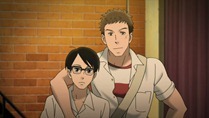 |
 |
 |
It would be hard to imagine an anime having two better opening episodes than Sakamichi no Apollon.
I promise never to take NoitaminA for granted again. Nothing like a couple of rough seasons (especially this last one) to make one appreciate what a luxury it is to have great and artistic anime in the middle of the week, and it’s been a long time since the block had two series of such stature and quality as Tsuritama and Sakamichi. The product of two renowned directors with a very individual sense of style, these shows couldn’t be more different – yet that and the fact that both are visually stunning and completely engaging makes them that much more perfectly complementary as partners.
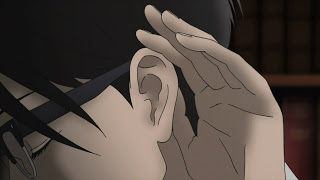 Sakamichi is many things. Where Tsuritama is surrealistic, Sakamichi is hyper-realistic – right down to the expensive and precise rotoscopic animation used for the jam sessions in Mukae’s basement (I’ve never seen drumming look this good in an animated film). I’m trying to find the words to describe this series – “elegant” certainly comes to mind, maybe even “regal”. Indeed, this has the feel of anime royalty to it – classy and smart and sensitive. There’s a certain nostalgic quality to it’s look at the mid 60’s, but the effect is as if we’re eavesdropping on the lives of these characters, picking out small details and getting caught up in the passions of the moment. There’s no element here that seems average – the cast is superb, and the music is incredible. I could listen to the ED over and over (I have, in fact) and never tire of it.
Sakamichi is many things. Where Tsuritama is surrealistic, Sakamichi is hyper-realistic – right down to the expensive and precise rotoscopic animation used for the jam sessions in Mukae’s basement (I’ve never seen drumming look this good in an animated film). I’m trying to find the words to describe this series – “elegant” certainly comes to mind, maybe even “regal”. Indeed, this has the feel of anime royalty to it – classy and smart and sensitive. There’s a certain nostalgic quality to it’s look at the mid 60’s, but the effect is as if we’re eavesdropping on the lives of these characters, picking out small details and getting caught up in the passions of the moment. There’s no element here that seems average – the cast is superb, and the music is incredible. I could listen to the ED over and over (I have, in fact) and never tire of it.
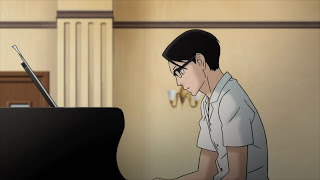 Sakamichi seems like a fairly straightforward story – two boys and a girl – but we’re seeing complicating elements begin to enter the narrative. One interesting twist is that Sentarou and Ritsuko are Christians, which is a relative rarity in manga and anime. Kaoru discovers this in a beautifully animated scene in their church, as he peeks in on a service while waiting for what he thinks is a study date with Ri-chan. It’s not at all clear yet what role their faith will play in the story, but there are hints that it plays a significant role in Sentarou’s life – Ritsuko is about to share the reason why he wears a cross at all times, but this is a topic Sentaro is clearly not willing to share with Kaoru yet.
Sakamichi seems like a fairly straightforward story – two boys and a girl – but we’re seeing complicating elements begin to enter the narrative. One interesting twist is that Sentarou and Ritsuko are Christians, which is a relative rarity in manga and anime. Kaoru discovers this in a beautifully animated scene in their church, as he peeks in on a service while waiting for what he thinks is a study date with Ri-chan. It’s not at all clear yet what role their faith will play in the story, but there are hints that it plays a significant role in Sentarou’s life – Ritsuko is about to share the reason why he wears a cross at all times, but this is a topic Sentaro is clearly not willing to share with Kaoru yet.
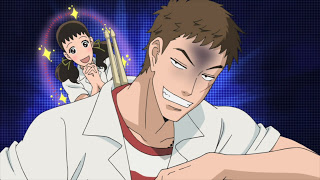 Before that happens, though, we can see that music is one thing he is willing to share. After a painfully realistic scene of bullying that results in Kaoru again being rescued by Sentarou (which for him is almost worse than the bullying, since in Kaoru’s mind it highlights for Ri-chan how different he and Sentarou are) the trio end up in the studio under the music shop, where we meet Junichi (Suwabe Junichi). “Brother Jun” is the Mukae’s neighbor and a college student home for summer break, and he serves as the trumpet player in the jam sessions Ritsuko’s Dad (Kitajima Zenki) joins in on upright bass. Kaoru has been practicing – playing the intro to “Moanin’” on the phonograph in his room and dashing downstairs to practice before his Aunt gets home (surely a scene that will feel familiar to many of us who loved music as kids) but he’s still reluctant to join in the session, doing so only after Sentarou insists.
Before that happens, though, we can see that music is one thing he is willing to share. After a painfully realistic scene of bullying that results in Kaoru again being rescued by Sentarou (which for him is almost worse than the bullying, since in Kaoru’s mind it highlights for Ri-chan how different he and Sentarou are) the trio end up in the studio under the music shop, where we meet Junichi (Suwabe Junichi). “Brother Jun” is the Mukae’s neighbor and a college student home for summer break, and he serves as the trumpet player in the jam sessions Ritsuko’s Dad (Kitajima Zenki) joins in on upright bass. Kaoru has been practicing – playing the intro to “Moanin’” on the phonograph in his room and dashing downstairs to practice before his Aunt gets home (surely a scene that will feel familiar to many of us who loved music as kids) but he’s still reluctant to join in the session, doing so only after Sentarou insists.
 As great as the episode was on the whole, I won’t deny this jam session is my favorite scene. Part of it is certainly the fact that I love jazz – when Kaoru said “I thought I understood the distinctive features of jazz in my head, but reproducing them was proving to be extremely difficult” I thought he perfectly captured both the magic of jazz and the agony of frustrated musicians everywhere. As much as my love for jazz, though, it’s Watanabe-sensei’s love for jazz that makes this scene sing for me. It’s a pleasure to watch a great director express his love for something as profound as jazz on screen, and Watanabe’s passion is evident in everything in this series – from that rotoscopic animation to his choice of jazz tracks to Kanno Youko’s BGM.
As great as the episode was on the whole, I won’t deny this jam session is my favorite scene. Part of it is certainly the fact that I love jazz – when Kaoru said “I thought I understood the distinctive features of jazz in my head, but reproducing them was proving to be extremely difficult” I thought he perfectly captured both the magic of jazz and the agony of frustrated musicians everywhere. As much as my love for jazz, though, it’s Watanabe-sensei’s love for jazz that makes this scene sing for me. It’s a pleasure to watch a great director express his love for something as profound as jazz on screen, and Watanabe’s passion is evident in everything in this series – from that rotoscopic animation to his choice of jazz tracks to Kanno Youko’s BGM.
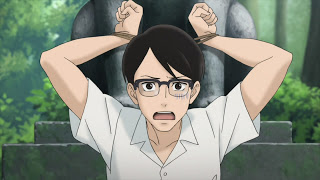 If there’s an overarching theme here, it’s definitely freedom. It cuts through the story at all levels – socially for starters, as the mid 60’s was the time when the cultural revolution was exploding everywhere and splitting society neatly down the middle. It seems to play out in Karou’s contrast with Sentarou too – both as expressed musically and in the way they live. There’s the imagery of the titular slope, which Kaoru loathes but Sentarou gleefully runs down. There’s the freedom of musical expression, with jazz representing the exhileration of improvisation and the classical that Kaoru is trained in the importance of structure. Kaoru doesn’t get this at the start of the episode – his method of trying to capture Bobby Timmons’ intro to “Moanin’” with musical notation – but he gets a taste of it by the end of their jam session in the basement. In short, Sentarou represents freedom and Kaoru inhibition (right down to choice of underwear) – but in almost all cases, freedom comes at a cost, and that’s the part of the story we haven’t reached yet. What is the price Sentarou pays for his freedom – is it tied into that cross he wears around his neck? I think this is going to be a subtle and layered exploration that defines much of the series.
If there’s an overarching theme here, it’s definitely freedom. It cuts through the story at all levels – socially for starters, as the mid 60’s was the time when the cultural revolution was exploding everywhere and splitting society neatly down the middle. It seems to play out in Karou’s contrast with Sentarou too – both as expressed musically and in the way they live. There’s the imagery of the titular slope, which Kaoru loathes but Sentarou gleefully runs down. There’s the freedom of musical expression, with jazz representing the exhileration of improvisation and the classical that Kaoru is trained in the importance of structure. Kaoru doesn’t get this at the start of the episode – his method of trying to capture Bobby Timmons’ intro to “Moanin’” with musical notation – but he gets a taste of it by the end of their jam session in the basement. In short, Sentarou represents freedom and Kaoru inhibition (right down to choice of underwear) – but in almost all cases, freedom comes at a cost, and that’s the part of the story we haven’t reached yet. What is the price Sentarou pays for his freedom – is it tied into that cross he wears around his neck? I think this is going to be a subtle and layered exploration that defines much of the series.
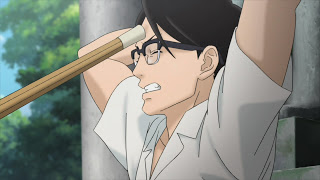 Of course there’s a love story here, too, with Kaoru obviously smitten with Ri-chan, to the point where he sacrifices his popsicle to prevent her from indirectly kissing Sentarou. Sentarou’s feelings about his osananajimi aren’t crystal clear. But after another lovely scene where the three leads row out into the islands of Kyushu to swim near a lonely beach, Sentartou engages in yet another rescue – this time a young woman named Yurika (Endo Aya) being harassed by three boys on the beach – and appears to fall in love with her on first sight. In addition we have the signature humorous touches that mark Watanabe as a director – the boy on the bicycle showing up at both ends of the boating trip, Kaoru’s cousin peeking in on him as he practices Timmons’ intro, the bully saying “Hey – my neck feels better!” after Sentarou roughs him up. Watanabe is among the very best at balancing whimsy and gravity, and he’s showing his mastery again here. Maybe “masterful” is indeed that one word I was looking for to describe Sakamichi no Apollon, because it certainly fits.
Of course there’s a love story here, too, with Kaoru obviously smitten with Ri-chan, to the point where he sacrifices his popsicle to prevent her from indirectly kissing Sentarou. Sentarou’s feelings about his osananajimi aren’t crystal clear. But after another lovely scene where the three leads row out into the islands of Kyushu to swim near a lonely beach, Sentartou engages in yet another rescue – this time a young woman named Yurika (Endo Aya) being harassed by three boys on the beach – and appears to fall in love with her on first sight. In addition we have the signature humorous touches that mark Watanabe as a director – the boy on the bicycle showing up at both ends of the boating trip, Kaoru’s cousin peeking in on him as he practices Timmons’ intro, the bully saying “Hey – my neck feels better!” after Sentarou roughs him up. Watanabe is among the very best at balancing whimsy and gravity, and he’s showing his mastery again here. Maybe “masterful” is indeed that one word I was looking for to describe Sakamichi no Apollon, because it certainly fits.
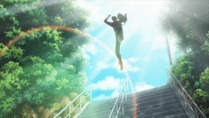 |
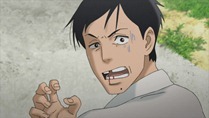 |
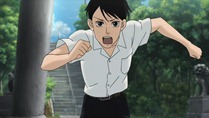 |
 |
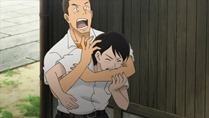 |
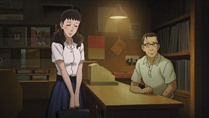 |
 |
 |
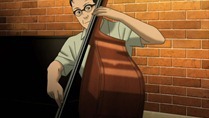 |
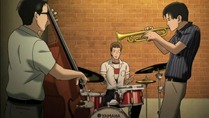 |
 |
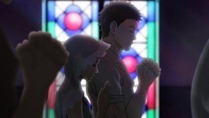 |
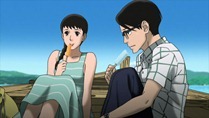 |
 |
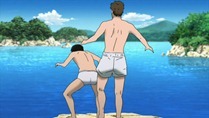 |
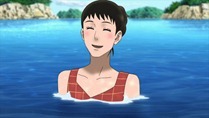 |
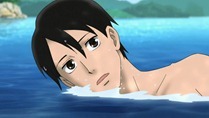 |
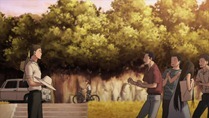 |
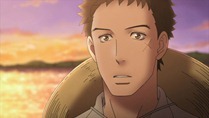 |
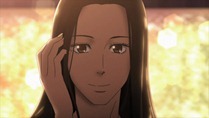 |
 |


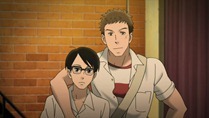
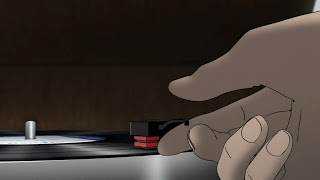

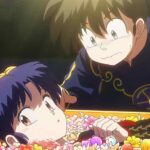
Lizzie
April 20, 2012 at 1:30 amI love the scene when sentaro was running down to see jun-nii but came back drag kaoru downstairs with him and introduced him as his friend to jun-nii lol I thought that scene was really sweet because sentaro looked so excited to actually have a friend ^_^ of course the scene with the jam session takes the cake in this episode it was totally awesome. Its funny how kaoru seems reluctant to become friends with sentaro but he is slowly starting to get comfortable around him and enjoys being in his company ^_^ I love this series.
admin
April 20, 2012 at 1:35 amWhen you're inhibited, people who aren't make you very uncomfortable. But I don't think either guy has ever really had a friend, so the natural impulse is sort of taking over.
dv
April 21, 2012 at 8:48 amTalking about inhibition… Guy with pants unbuttoned is not okay. But guy in his underpants is alright with ta gal? Le business wat this?
debussylover
April 20, 2012 at 2:49 amThis episode definitely seemed to give glimpses of their lives, making us seem as third-person viewers, but it was really well executed. To be honest, however, the short snippets pieced together gives a much rapid development but I think it's cause they are limited in the number of episodes. However, I loved the jazz session, the only qualm about it is that I wished it could have been longer haha.
jebnemo
April 20, 2012 at 4:18 amI enjoyed the first episode so much that I've watched it a few times. I'll watch it and this episode again tomorrow. The "Bach" trumpet in the opening just makes me smile, and I guess that's the blue yarn of fate in the ending.
Ryan
April 20, 2012 at 5:47 amIt is amazing that we are gifted with two great series in the same hour this season. I had almost lost faith in the direction the entire anime industry was heading towards until now.
By the way, what is retroscopic animation? Do you by chance actually mean rotoscopic animation?
admin
April 20, 2012 at 8:00 amLOL – yeah, too many damn posts to crank out on Thursdays gave me a brain freeze.
SQA
April 20, 2012 at 6:02 amCultural Revolution in China started in May 1966, which is exactly when this series is set. The European & American upheavals won't start until the summer of 1968. So the time frame is a brilliant for this type of series.
I just hope we don't get any face-smacking screw ups with the Christianity aspect. Mostly as Redemption is a very different context in Western vs Eastern religious traditions. I imagine that will have a good bit behind it.
One other little note, Kaoru isn't your normal anime MC. Most of those wouldn't even make a move for the next 6 episodes. While his attempt at a date with Ritsuko got redirected, he also made an early move and has shown a very strong will. Along with a will to change. He's just physically small and somewhat weak. But he also realized he's probably faster than the bigger guys, haha.
admin
April 20, 2012 at 8:03 amI suspect Kaoru is more proactive in part because Watanabe is trying to shoehorn a long-running manga into 12 episodes.
As for cultural revolution, trust me on this – it was very much underway in the US and Europe by 1966. The war was in full swing, psychedelic rock and the counterculture movement were growing exponentially, the summer of love of was only a year away.
Luxorcism
April 20, 2012 at 9:07 am😮 I didn't notice the rotoscoping. I did, however, notice that the bass/piano playing animations were incredibly detailed to such an extent that I went looking for a video online. http://www.youtube.com/watch?v=knsMUkksLgg
And I was waiting for you to mention their choice in underwear. xD
Speaking of the cultural revolution: I know China had it in 1966, and that the western world had a huge outpour of the counterculture and stuff. It's an exciting time, one that I haven't seen much in TV or cinema. And it's especially exciting to see the contrast in the decentralized media at the time with the current state of old media, as biased as they are today.
Seishun Otoko
April 20, 2012 at 7:11 pmahhhh… love at first sight…
dv
April 21, 2012 at 8:44 am@Enzo: there you go again. 🙂
"these shows couldn't be more different"